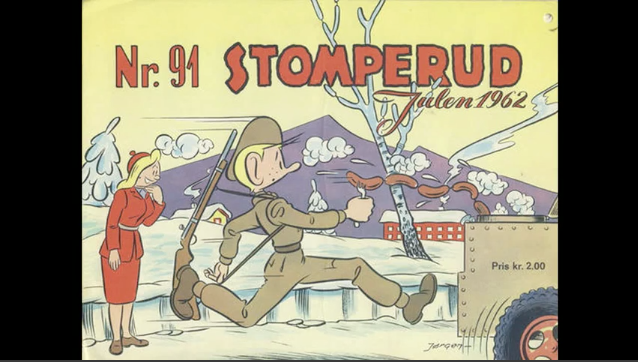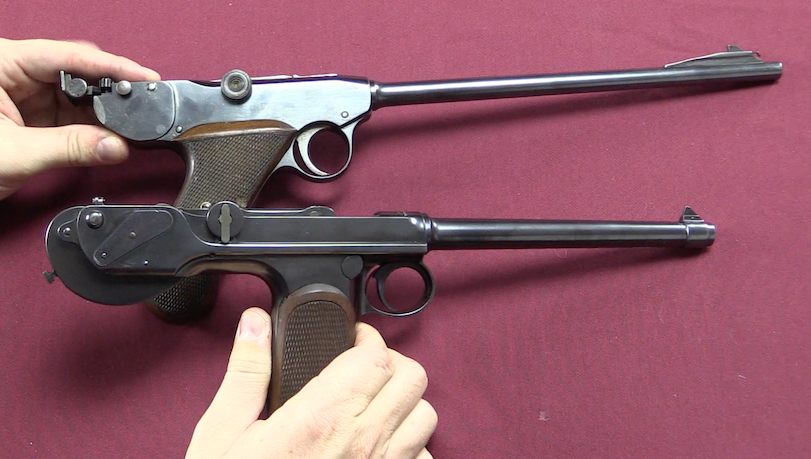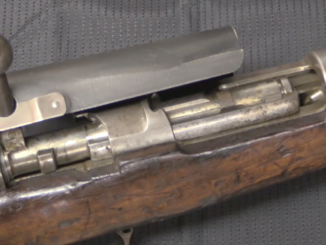Lot 517 (5.25mm) and lot 444 (6.35mm) in the September 2019 RIA auction.
The Liliput was made by the August Menz Company in Germany during the 1920s, in several variations. It was introduced in both 4.25mm and 6.35mm (.25 ACP) and also later offered in 7.65mm (.32ACP). These were typical defensive pistol chambering at the time, although the 6.35mm version was much more popular than the 4.25mm one. They are simple blowback pistols, and competed against similar but more successful designs like the FB Baby Browning, Walther Model 9, and Mauser 1910. For a detailed history of the Menz Company and its pistols, check out Ed Buffaloe’s page on the company.




“(…)4.25mm(…)”
Size comparison against .22 rim-fire photo:
http://municion.org/4_25/4_25.htm
“(…)both 4.25mm and 6.35mm (.25 ACP) and also later offered in 7.65mm (.32ACP).(…)”
Photos of all of these versions:
http://www.littlegun.info/arme%20allemande/a%20menz%20gb.htm
Size comparison drawing:
http://www.earmi.it/armi/atlas/212.htm
Some points;
Main rival of this small pistol should be Walther Model9 which introduced nearly same time 1921. Browning Baby ten years, Mauser WTP2 nearly twenty years later. All being approximately in same size excepting Walther nearly one centimeter shorter than all.
Field stripping of Walther and Menz followed nearly the same way as being using the striker tunnel as a guide for slide reciprocal movement at back and fixed barrel through recoil spring recess at the front.
Same take down is recently being used in Walther(Umarex)CCP and most of zamak blank/gas pistols novadays.
“Main rival of this small pistol should be Walther Model9 which introduced nearly same time 1921. Browning Baby ten years, Mauser WTP2 nearly twenty years later.”
Well, in fact if someone wanted in 1920s buy 6,35 mm German-made then he have many choices. For some examples, see section DEUTSCHLAND here: http://www.vestpockets.bauli.at/archiv/archiv.htm – Fahrrad- und Waffenfabrik C.G. HAENEL or Aktiengesellschaft LIGNOSE, Berlin, Abteilung Suhl or J.P. SAUER & SOHN in Suhl or Emil ZEHNER Metallwarenfabrik, Suhl
Thanks Daweo. .25 ACP history began with 1906 FN vest pocket pistol. Many similar size handgun had been made after then but, having same lenght of barrel with an over all lenght at least one centimeter shorter history began with Walther9 and Menz… Browning Baby and Mauser VTP2 followed threreafter. However, there might be some other lesser popular brands like Star and Mann at that time.
So you are looking for 6,35-mm automatic pistols which have small overall length?
Then you might choose:
Mann – https://unblinkingeye.com/Guns/Mann/mann.html – overall length 104 mm
Helfricht Modell 2 or Modell 3 – https://www.collectorsfirearms.com/helfricht-model-1-25-pr42755/ – overall length 105 mm
Small calibers were a lot more intimidating before trauma centers and antibiotics.
Here’s what Cartridges of the World (13th edition, bonus CD-ROM) has to say about it;
4.25mm Liliput Auto
(4.25mm Erika Auto)
Historical Notes:
Another of the miniature European auto-pistol cartridges, this 4.25mm (.17-caliber) cartridge was used in the German Liliput pistol, introduced in 1920, and this name stuck to it. However, this cartridge actually originated in Austria, about 1913-’14, for the Erika auto pistol. Thus, it is sometimes referred to as the 4.25mm Erika. Both gun and cartridge have been obsolete for many years.
General Comments:
The 4.25mm round is of greater power than the 2.7 or 3mm Kolibri, but that still doesn’t mean it’s much of a cartridge. With a 12- to 15-grain bullet and a muzzle velocity around 800 fps, it develops only 17 ft-lbs of muzzle energy—still far below the 73 ft-lbs of the .25 Automatic. It could not be considered effective for serious self-defense or any kind of hunting. However, it would kill rats or mice at short range. As with all these miniature cartridges, it is potentially dangerous and could inflict a serious wound at short range.
Its principal use would be for indoor target practice. Ammunition is scarce and too expensive to shoot in
quantity, regardless. This case is not reloadable.
4.25mm Liliput Auto Factory Ballistics
Bullet (grains) 12-15
Powder (Grains) Factory Load
Velocity ~800 F/S
Energy ~ 17-21.3 FPE
Put simply, compared to the 4.25mm Erika/Liliput, the .25 ACP is a Magnum. There were and are air pistols in .177in with greater muzzle energy than the 4.25mm round.
cheers
eon
I remember seeing the 4.25 mentioned in one of Alistair Maclean’s novels as a hideout pistol. Maybe Fear is the Key?
Where Eagles Dare. It was the pistol Heidi smuggled into the Schloss Adler for Mary (aka “Maria Schenk”) to use.
cheers
eon
More than one McLean. When Eight Bells Toll, Puppet on a Chain, maybe others. He seemed never to have heard of many other guns besides Luger, Colt Peacemaker, and the Lilliput. Mauser got mentioned in passing. I greatly enjoyed his books when I was a teenager and now find them a little prissy. I still remember his best line, the narrator musing as a Colt Peacemaker is aimed at him: “I wished Colonel Colt had invented something useful, like safety pins.”
I think he was kind of fond of them. I haven’t read Fear Is the Key, but its wielded by Mary in Where Eagle’s Dare. A Baretta 950 Jetfire (in .25 ACP) was apparently used in the movie, but MacLean specifies the extra tiny Liliput in the book (actually written by MacLean as a “novelization” after he’d written the screenplay).
MacLean actually wrote the screenplay at the request of Richard Burton. Burton wanted to do an “action movie”, while having previously been more noted for either straight dramas or a few spy movies (The Spy Who came In From The Cold).
MacLean suggested a WW2 scenario, since he and Burton were both veterans of same, and both had done war movies previously; MacLean’s first film adaptation was of his war novel HMS Ulysses.
Burton managed to get Elliot Kastner and Jerry Gershwin interested in producing it, and they got Brian Hutton to direct. They also got Clint Eastwood to co-star.
Other than the fact that the result was a damn good action adventure movie, one side effect of it was that after it was done in 1969, Kastner, Gershwin, Hutton and Eastwood re-teamed the next year (1970) to do Kelly’s Heroes.
cheers
eon
Named after the island and its little people from Gulliver’s Travels maybe?
I think you are right.
Small handguns for small people (preferably ladies I suppose) 🙂
Back in those days, the bark was worse than the bite in a nasty manner. If some creep tried to force himself upon a lady and she emptied the magazine of a Lilliput pistol in his direction, the sound of gunshots alone would attract lots of attention, and some of that from local beat-cops. At that point, the molester is presented with a choice even if he isn’t hurt badly: Continue to satisfy his desires and risk getting a truncheon (or hammer) to the back of his head, or run like hell. Did I mess up?
Quite plausible scenario. Also, and lets not forget, also the “public” women needed some means of discouraging competition, not to mention “shoplifters” 🙂
Sounds like something one could turn from brass stock, time-consuming, but straightforward if one has a mouse issue.
In their day such pistols popular with ladies – either to deter unwanted attentions or self protection guns for working girls. The ability to produce and point a pistol (even so small a one as these) and / or fire a warning, alarm or ‘distraction’ shot. Being ‘useful’ in a number of circumstances. With the advantage that they wound, but unlikely to kill / murder.
For those who like details:
https://www.lugerforums.com/threads/menz-liliput-4-25mm-pistols-draft-production-and-finish-tables-and-queries-for-dr-klein-and-other-knowledgeable-members.125931/#post-977061